Fasten your goggles: New aquatic center is on its way
Olympic medal-producing aquatics program gets gift of training pool, diving tower
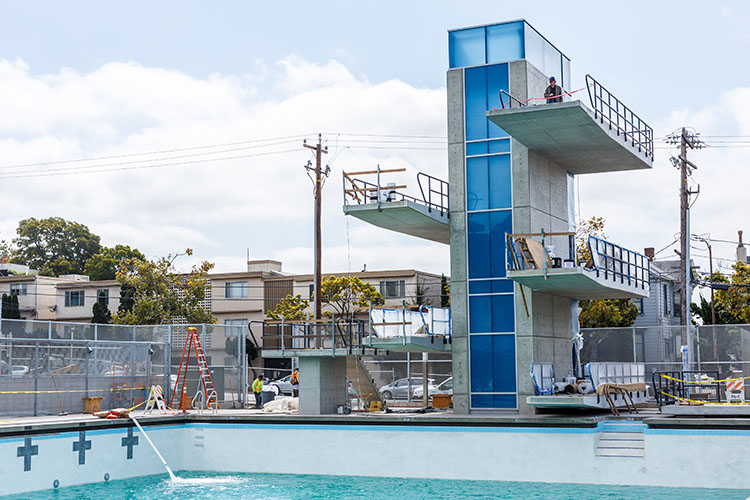
September 2, 2016
Berkeley’s aquatics program is legendary, producing top athletes for decades like the students and alumni just back from the 2016 Summer Olympics bearing 19 swimming medals, including eight golds, and a world record – Ryan Murphy, Missy Franklin, Dana Vollmer, Nathan Adrian, Anthony Ervin, Kathleen Baker, Abbey Weitzeil, Josh Prenot and Tom Shields.
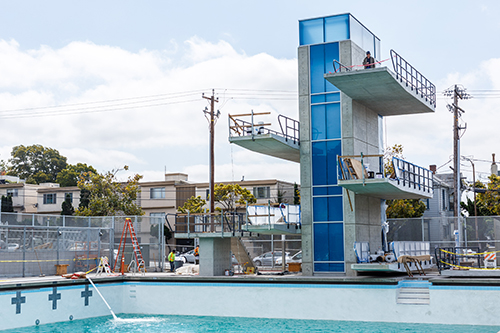
As the pool is filled with water, work wraps up on Berkeley’s first-ever diving tower, with five platforms. The highest is 10 meters, or about three stories, tall. (UC Berkeley photo by Ryan Hoang)
Their success is remarkable, but especially because their training on campus has been in one congested pool shared over the years by four intercollegiate teams – men’s and women’s swimming and diving and men’s and women’s water polo – plus physical education classes, scuba instruction, Berkeley Rec Sports swimmers and club water polo teams.
Now, the future of these athletes and Cal Athletics looks even brighter with the arrival of Legends Aquatic Center, scheduled to open in late September. Located on Bancroft Way, next to the Tang Center, it’s designed primarily for the training of Cal’s intercollegiate swimmers, divers and water polo players.
The name also honors coaching legends at Berkeley like the late Pete Cutino, considered one of the nation’s finest water polo coaches, and the four devoted alumni – Ned Spieker, Rick Cronk, Don Fisher and Warren Hellman, former student-athletes on the Cal men’s swimming and diving and water polo teams – who launched a “More Water” campaign that attracted dozens of donors and led to construction of the new $18 million facility.

The pool at Legends Aquatic Center slowly fills with 1,033,589 gallons of water, a job that will take about 35 hours. (UC Berkeley photo by Hulda Nelson)
“Cal has a world-class aquatics program and has done it with fewer resources than most competitive programs. That’s why several of us decided to help,” says Spieker, a prominent real estate investor who attended Berkeley in the 1960s. “We needed more water at Cal, more ability to work out, and when a site became available, we jumped on it. This will give the program a lot more flexibility.”
“This center will help us continue to attract intercollegiate athletes at the top level,” adds women’s swimming and diving coach Teri McKeever, who among many honors coached the U.S. women’s swim team at the 2012 Summer Olympics in London. “We’re all so excited. We’ve talked about this for a decade, and now it’s a reality.”
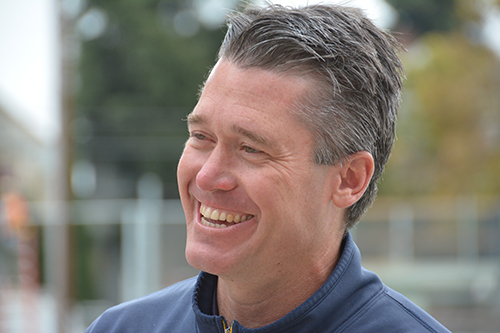
Dave Durden, head coach of the Cal men’s swimming and diving team, was assistant coach for Team USA at the 2016 Summer Olympics. (UC Berkeley photo by Hulda Nelson)
In 2012, the primary donors – Spieker and his wife, Carol; Cronk, retired president of Dreyer’s Ice Cream, and his wife, Janet; Gap founder Fisher, who died in 2009, and his wife, Doris, and their family; and financier and power broker Hellman, who died in 2011, and his wife, Chris, and their family – set up an independent nonprofit organization, Cal Aquatic Legends, to raise funds for the project. They then leased land from the campus to start construction. With the work now finished, the center, to be run by Cal Athletics, is being donated back to Berkeley, complete with a 52-meter pool, a team room, locker rooms with radiant heat flooring, outdoor videoboards and Berkeley’s first diving tower, which is 10 meters (about three stories) tall with a glass-enclosed stairwell.

Kathleen Baker earned an Olympic silver medal in Rio in the 100-meter backstroke, marking the fourth consecutive Olympics at which a Cal swimmer medaled in the event. (USA Today Images photo)
“It’s really a landmark because of that diving tower,” says Berkeley alumnus, donor and former water polo player Peter Schnugg, the aquatic center’s project manager. “With divers leaping off of that, it’s going to be spectacular. There will be plenty of places for people to watch,” especially through fencing along a walkway between the Tang Center and the pool.
Passersby also might catch a glimpse of Bay Area Olympians – including the alumni who brought 10 of Berkeley’s 19 swimming medals home from Rio – regularly working out and being coached by McKeever and men’s swimming and diving coach Dave Durden. Many of Berkeley’s greatest student-athletes continue to train with their coaches long after graduation.
“That’s a cornerstone of my program,” says McKeever. “It’s the commitment of anyone still training here, whether it’s Natalie (Coughlin), Dana, Caitlin (Leverenz), Nathan, and it’s my expectation that they keep setting a great example for undergraduate athletes by returning to campus to inspire, mentor and show them the possibilities.”
Champion-worthy digs
The possibilities that Berkeley, Cal Athletics and its donors dreamed of for the new facility are becoming reality. Last week, 1,033,589 gallons of water were pumped into the Olympic-sized pool eight hours after the deep tank’s bottom and walls were coated with white plaster, then smoothed. Next tasks include grading the parking lot, installing exterior panels on the team room and outfitting the locker rooms.
Student-athletes will use the multi-purpose team room, with one wall facing Bancroft Way, for stretching, yoga, dance, meetings and to relax and study. The room’s windows are made of opaque, blue-tinted glass and are part of a glass wall system that, at the main entrance, will allow passersby to glimpse the teams that are training.
In the 52-meter pool, athletes can swim the 25-yard width, the standard “short course” distance for collegiate races, or in the other direction to do the 50-meter “long course” that’s traditional in Olympic competitions.
The pool’s extra two meters of length accommodate a movable bulkhead, a floating island used to divide the pool into sections that will be hoisted into place this week with a large crane. Coaches use a bulkhead creatively, positioning it, for example, to create a very short pool in which swimmers can focus exclusively on their turns.
On deck, state-of-the-art video equipment will capture the athletes’ and teams’ workouts and produce instant images on an outdoor monitor that is close enough to the pool that no one has to climb out to see.

The multi-purpose/team room borders Bancroft Way and will be used for yoga, meetings, homework and rest. (Photo by Ryan Hoang)
“Before, students would have to get out of the water and view video on an AV roller cart with a TV monitor hooked up to TiVo,” says men’s water polo coach Kirk Everist. “Now, we have a bigger viewing platform.”
In the locker rooms, student-athletes will find radiant heat and Cal logos in the flooring; skylights; sturdy lockers with thick, tempered glass doors and industrial washers and dryers. These features, an upgrade to the cold, wet locker rooms at most pools, were funded by donors Leslie and Andy Schilling and by Nadine Tang and Bruce Smith.
The dizzying diving tower, flanked by springboards, is a big first at Berkeley. About as tall as a three-story building, it contains platforms at progressive heights – 1, 3, 5, 7 and 10 meters – that divers can conquer as they advance in skill to the top. The water below is 17 feet deep, becoming more shallow on the way to the eight-foot depth at the pool’s other end.
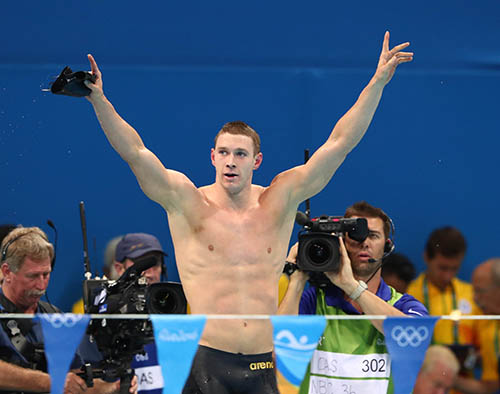
Ryan Murphy won gold medals in the 100- and 200-meter backstroke at the 2016 Summer Olympics and also set a 100-meter backstroke world record in the 4×100 medley relay. (USA Today Images photo)
Until now, recruiters have had to break some shocking news to divers interested in attending Berkeley: They’d be practicing at Stanford, on its diving tower, since Berkeley didn’t have one of its own. “It’s ironic, but that’s been the reality for a long time,” says Everist. “If you want to train at the highest levels in diving, at Olympic levels, you have to train on a platform. We’ve been forced to go to Stanford to do that, and now we won’t have to.”
“It’s been hard for recruiting and challenging for the men and women who’ve had to drive 45 miles to Palo Alto two times a week,” adds McKeever. “And it’s been hard on the program from a competitive standpoint.” Since swimmers and divers are on the same team, the team suffers at meets if there aren’t enough divers to earn points in diving events.

A view from Bancroft Way of work being done on Legends Aquatic Center’s team room. (UC Berkeley photo by Ryan Hoang)
“Diving is an event at a swim meet, just like butterfly or backstroke,” says Alicia Rowell, Cal Athletics’ assistant athletic director for capital campaigns and administration. “If we don’t have divers who can compete at the national level, we score zero points in the diving events at NCAAs. It hurts us every time.” Now, she adds, Berkeley will be a destination for divers, who will climb to the platform in a glass-enclosed stairway – protecting them on chilly Bay Area days – that’s emblazoned on its front with the words “California” and a Cal logo on the bay side.
More water, more pride
Spieker Aquatics Complex, on the other side of Bancroft Way, will still be used for training by Berkeley’s intercollegiate teams, but much less so because of the new facility just down the hill. With less demand on its schedule, Spieker – which opened in the early 1980s in honor of Ned and Carol Spieker, who gave the lead gift for its construction – now has the capacity to provide more recreational swim hours to the campus community.
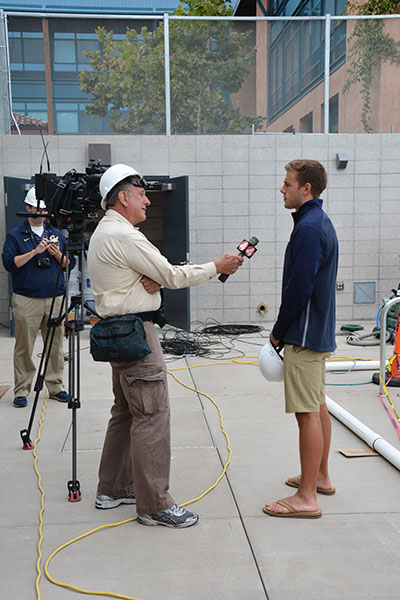
KPIX Ch. 4 interviews swimmer Hunter Cobleigh for a story on the new aquatics center. (UC Berkeley photo by Hulda Nelson)
Intercollegiate Athletics has been using 53.5 hours a week of exclusive pool time for training at Spieker, but that number will drop to about 34 hours a week. In addition, the hours at Spieker when student-athletes and recreational swimmers shared the pool – up to 21.5 hours a week – all will become available for campus use.
With extra space, says Schnugg, water polo players can spread out for drills to develop individual skills and, in the summer, more returning athletes can train on campus. Additionally, the water polo program will be able to host more collegiate and club tournaments by using both the Spieker and Legends facilities.
For swimmer Andrew Seliskar, a sophomore in mechanical engineering, it also means student-athletes won’t have to stress trying to put together a schedule of classes that, in the past, hasn’t meshed well with their teams’ limited workout opportunities at Spieker.
“This was especially true during the summer months when we were preparing for the Olympic trials,” says Seliskar, who was named 2016 Pac-12 Newcomer/Freshman of the Year and Swimmer of the Meet at the 2016 Pac-12 Championships. “For students taking summer classes, there were direct conflicts between practice times and class schedules.”
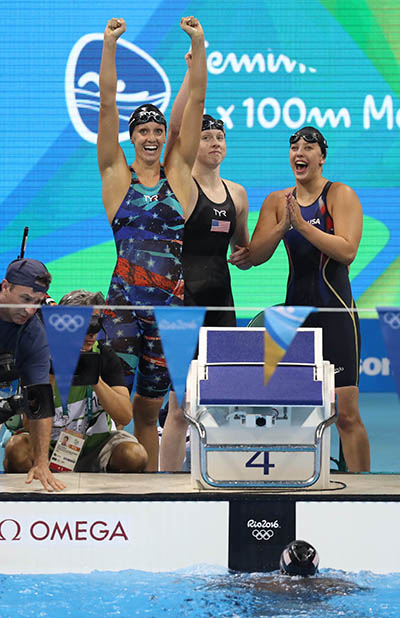
Dana Vollmer (left) and Kathleen Baker (right) cheer with Lilly King after winning, along with Simone Manuel (in pool), the women’s 4×100 medley relay final in Rio. (USA Today Images photo)
Schnugg says some student-athletes have had to “go to school in the summer or stay an extra semester or two to finish their degrees” because the classes they needed met during their teams’ only available hours at Spieker pool. “The life of the student-athletes,” he adds, “is going to be significantly improved.”
“While Spieker is a fantastic pool that we cherish,” adds Seliskar, “it also was difficult for our entire men’s and women’s teams to train simultaneously. We’d often have a shortage of lanes. Now, our coaches will be able to hold workouts on a much more personal and individual level, because we’ll have more space and time. I know the new training facility will have an immediate impact on our team.”
“It will be a great source of pride for Berkeley and, dare I say it,” adds McKeever, “will help produce even more success for Cal athletes in the water.”